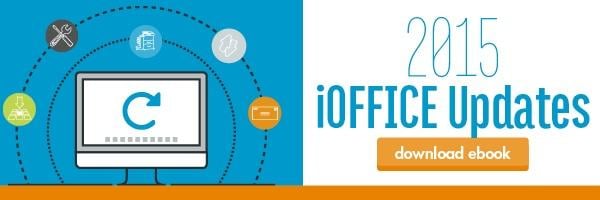Increase Facilities Efficiency Through IWMS Mobile Applications


Regardless of what industry you’ve landed a position in, the requirements for being a great leader remain consistent. Maintaining a healthy knowledge of the trends in workplace tools and listening to your customer are both critical components for successful managers, particularly in the workplace management profession.
As creators of integrated workplace management systems, these elements of great leadership are particularly important for the iOffice team, as our own workforce and our clients rely on us for successful workplace tools.  We maintain a consistent and open line of communication with our customers and our staff to identify which workplace tools offer the most support, what benefits they regularly enjoy, and where improvements could be made.
We maintain a consistent and open line of communication with our customers and our staff to identify which workplace tools offer the most support, what benefits they regularly enjoy, and where improvements could be made.
With workplace mobility on the rise and approximately 61% of employees now working outside the office at least part of the time, it’s no surprise that the importance of mobile workplace tools has risen. Our workforce, as well as our customers, report an increase in facilities efficiency since implementation of a mobile IWMS.
Today we will examine a few aspects of workplace management that have been impacted by these mobile solutions. But first, let’s take a look at a few statistics that might surprise you.
The Numbers Prove: Mobility is on the Rise
How much time do you spend on your smart phone or tablet each day? 91% of all U.S. citizens report having their mobile device within reach 24/7. Twenty-four hours a day, seven days a week! These numbers prove just how integral a part of our lives these devices have become. And it’s not just our personal lives that have been enhanced through mobility; business productivity has benefited from these numbers as well.
In a 2014 Gallup research poll, “when asked how much time in a typical seven-day week is spent working remotely… employees who report checking their email frequently say they spend nearly 10 hours working remotely. Those who occasionally, rarely, or never check job-related email outside of work report spending nearly four hours a week working remotely.” Whether from home, in the car, or at the restaurant waiting for dinner to arrive, our workforce is on the move and is taking their work with them. As the business environment continues to get more competitive, then, it has become increasingly more important that we offer our workforce the tools needed to perform without the boundaries of space and time.
How Can Mobile Apps Improve Facility Efficiencies?
Increased efficiencies and reduced expenses. Of the laundry list of goals facilities managers have on their agenda, these seem to be the primary focus. Improved efficiencies come in many forms, but “reduced cycle time” seems to have the greatest impact on the  organization as a whole and is, unsurprisingly, one of the most impacted by mobile tools. If employees can access information quickly and have the ability to put in for requests and update information directly from their mobile device, the process is that much more expedient. This allows them to respond to a greater number of requests with ease and confidence, resulting in increased productivity on every level of the enterprise.
organization as a whole and is, unsurprisingly, one of the most impacted by mobile tools. If employees can access information quickly and have the ability to put in for requests and update information directly from their mobile device, the process is that much more expedient. This allows them to respond to a greater number of requests with ease and confidence, resulting in increased productivity on every level of the enterprise.
So, what mobile applications are the most beneficial and widely used by facilities management teams?
Today’s facilities manager spends a majority of their work day on the move. They must have a tool that allows for them to move freely about the building, making decisions based on accurate and current information. Many of these decisions involve the top two expenses for enterprises today: their people and real estate. Space & Move Management software is an integral part of this process. Through the use of SaaS-based software and complementing mobile apps, management is able to gain critical knowledge regarding how space is being used and by whom.
This visual understanding of space utilization ensures more efficient planning of allocation moving forward and helps map out moves. It provides teams with the analytics to properly identify and reallocate underutilized space, ensuring the workforce’s spatial needs are met. Ultimately, this engenders improved efficiencies, a more engaged and productive workforce and, in turn, a reduction in churn rates.
Part of understanding and controlling the workspace lies in our ability to offer employees the space they need, when they need it. As the ability to collaborate becomes increasingly important, many FM teams are looking to room reservation tools to achieve greater efficiencies. Your room reservation application spares the workforce the frustration of finding a space double-booked, freeing up their time to focus on what matters most. And since each module offers detailed analytics, management gains further insight into which spaces are most used. This allows for more fluid planning of both present and future workspace needs.
Modern technology has offered us unprecedented knowledge regarding what factors influence the bottom line and our mindset concerning how we handle these business components. Perhaps one of the greatest shifts has been in how we handle the maintenance of assets and equipment. Through tools such as service request applications, users have the ability to report an issue as soon as it arises. The workforce can offer details regarding the service request and even include pictures when necessary. And through key metrics, facilities teams are able to develop a well thought-out preventative maintenance plan, further reducing downtime. The result, is enhanced fluidity and productivity, further solidifying an engaged workforce and a boost in the bottom line.
Before mobility became an option, management was able to track assets through spreadsheets with a fair amount of accuracy. As our employees move about the building and work from remote locations, it has become increasingly difficult for FMs to track individual asset usage and location. Your IWMS and mobile applications are integrated to allow consistent access to relevant information, making adjustments as the need arises. As FMs move throughout the building, they can update changes in employee location/space, asset location, and request any servicing needs arising from the most recent move.
Today’s business landscape is both complicated and dynamic; with facilities managers facing greater challenges than ever before. As businesses begin to understand more about what makes their workforce tick, it has become increasingly evident that each business component works hand-in-hand with the other. Fortunately, technology is not only keeping up, it is leading the change, offering heightened knowledge, improved flexibility, and mobility. With the right tools in place, we have the power to improve efficiencies on an organizational and individual level, establishing ourselves as industry leaders in the process.
Want to learn more about mobile applications and their impact on the workplace? Visit our blog: What You Should Look for When Choosing an IWMS That Offers Mobile Apps.
